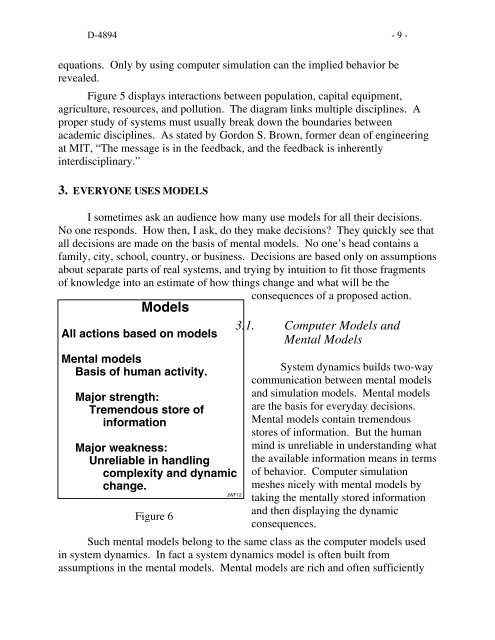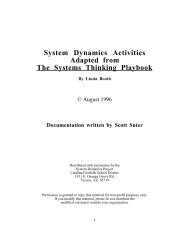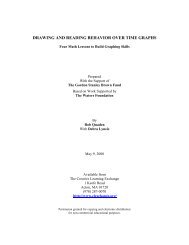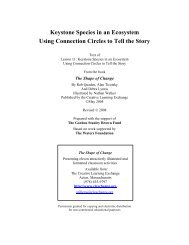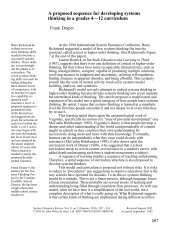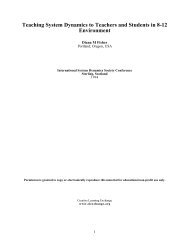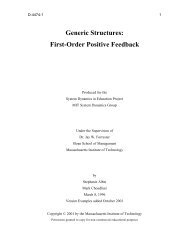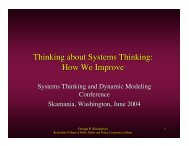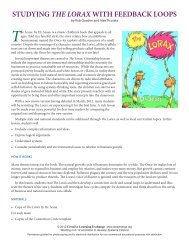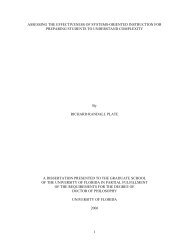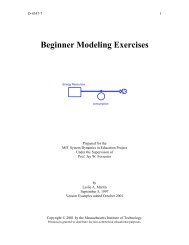Some Basic Concepts in System Dynamics - Creative Learning ...
Some Basic Concepts in System Dynamics - Creative Learning ...
Some Basic Concepts in System Dynamics - Creative Learning ...
Create successful ePaper yourself
Turn your PDF publications into a flip-book with our unique Google optimized e-Paper software.
D-4894 - 9 -equations. Only by us<strong>in</strong>g computer simulation can the implied behavior berevealed.Figure 5 displays <strong>in</strong>teractions between population, capital equipment,agriculture, resources, and pollution. The diagram l<strong>in</strong>ks multiple discipl<strong>in</strong>es. Aproper study of systems must usually break down the boundaries betweenacademic discipl<strong>in</strong>es. As stated by Gordon S. Brown, former dean of eng<strong>in</strong>eer<strong>in</strong>gat MIT, “The message is <strong>in</strong> the feedback, and the feedback is <strong>in</strong>herently<strong>in</strong>terdiscipl<strong>in</strong>ary.”3. EVERYONE USES MODELSI sometimes ask an audience how many use models for all their decisions.No one responds. How then, I ask, do they make decisions? They quickly see thatall decisions are made on the basis of mental models. No one’s head conta<strong>in</strong>s afamily, city, school, country, or bus<strong>in</strong>ess. Decisions are based only on assumptionsabout separate parts of real systems, and try<strong>in</strong>g by <strong>in</strong>tuition to fit those fragmentsof knowledge <strong>in</strong>to an estimate of how th<strong>in</strong>gs change and what will be theconsequences of a proposed action.ModelsAll actions based on modelsMental modelsBasis of human activity.Major strength:Tremendous store of<strong>in</strong>formationMajor weakness:Unreliable <strong>in</strong> handl<strong>in</strong>gcomplexity and dynamicchange.JWF12Figure 63.1. Computer Models andMental Models<strong>System</strong> dynamics builds two-waycommunication between mental modelsand simulation models. Mental modelsare the basis for everyday decisions.Mental models conta<strong>in</strong> tremendousstores of <strong>in</strong>formation. But the humanm<strong>in</strong>d is unreliable <strong>in</strong> understand<strong>in</strong>g whatthe available <strong>in</strong>formation means <strong>in</strong> termsof behavior. Computer simulationmeshes nicely with mental models bytak<strong>in</strong>g the mentally stored <strong>in</strong>formationand then display<strong>in</strong>g the dynamicconsequences.Such mental models belong to the same class as the computer models used<strong>in</strong> system dynamics. In fact a system dynamics model is often built fromassumptions <strong>in</strong> the mental models. Mental models are rich and often sufficiently


